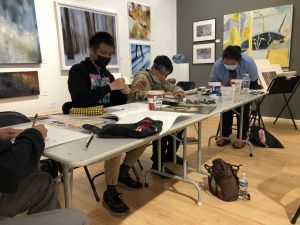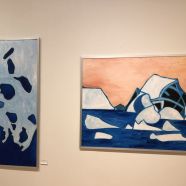On Being a Community Artist
I arrived in Chapel Hill in August 1990 from La Jolla, California, with my anthropologist husband Robert Levy (now deceased) to spend a year as a scholar at the National Humanities Center. It was hot and I waited in vain for the sea breezes to mitigate the August humidity and heat. We moved to North Carolina permanently in 1991 and thirty-two years later I am still here, climate adapted and very much a citizen of Carrboro/Chapel Hill.
On moving to North Carolina in 1990, I freed myself completely from the ideas of the Californian art group and university classes to which I belonged and started working alone focusing on local landscapes. I also became involved with the Friends of the Carrboro Branch Library and their quest to get an Orange County Library in Carrboro.
With the opening of the Carrboro Branch Library in 1995 at the McDougle School’s media center, the Friends set up an art gallery in that shared space for two-dimensional artworks. This gallery was run by an art committee, which I headed for twenty-five years. Our purpose was not only to show art but also to emphasize the fact that libraries were becoming multifunctional cultural centers. Furthermore, because the library was located within the school, it was hard to find, and we wanted an activity that would bring people into that space. Then, in 2022, with the promise of a new library in Carrboro, the branch closed. By that time, the Library Art Program had won state and national awards and shown the work of over 2,000 culturally diverse local artists. During my time managing that program a few more community spaces opened locally, which were mostly managed by volunteer artists. Meanwhile, throughout the 1990s, the local Cultural Arts Group, to which I belonged, urged Orange County to have a full-time Arts Commission administrator, a cause that was eventually fulfilled after the millennium. That same group also encouraged the Town of Carrboro to buy the local Baptist church, which, after its repurposing, became the Carrboro Century Center.
At that same time and after a solo exhibition at the Horace Williams House, I was invited to serve on the House’s art committee of which I am currently co-chair along with Tama Hochbaum. At the House, home of Preservation Chapel Hill, a group of nine volunteer artists administer seven exhibitions a year in a fifty-year-old program that has launched the careers of many significant artists. While working as a voluntary arts administrator, my professional life as a painter also developed and included a show in Venice, Italy, and exhibitions at many other venues. My travels to foreign parts such as Italy, China, Antarctica, and the Norwegian Arctic were fruitful artistic encounters with a variety of exotic and natural forms as well as with the horrors of climate change, which resulted in ensuing issue-focused exhibitions locally and further afield. Meanwhile, my annual visits to Britain kept me in touch with my roots and resulted in my many British landscape paintings.
Thirteen years ago, FRANK Gallery opened on Franklin Street, Chapel Hill. On becoming a member artist there I partnered with Barbara Tyroler in developing that gallery’s Outreach Program—an essential element and requirement in the multifaceted mission of that nonprofit fine arts gallery. We staged shows featuring artists with disabilities, local nonprofit groups, and world health projects. In addition, in 2012, together with volunteer Frances Hamer, FRANK founded a Karen (Burmese) refugee youth group. Eleven years and over eighty students later the FRANK Karen Youth Art Group has witnessed some of its senior students graduate with UNC degrees; one who, after graduating from Guilford College, became the executive director of the Karen Transplanting Traditions Community Farm; and one who is a Chapel Hill firefighter. Our current students are entering various strata of the local medical field and one is transferring from Alamance Community College to UNC–Chapel Hill to study studio art. Most of our students were born in Thai refugee camps where they lived for years prior to coming to the United States. Through our program they have managed, as first-generation Americans, to look forward to rewarding futures with confidence and skills.

Over thirty years of service to the arts in our community have taught me a lot about making my own work relevant to the times. I have shown in a number of climate change/action exhibitions, including “ Ice Counterpoint” at UNC–Chapel Hill’s Global Education Center and “Vanishing Ice,” which traveled to four North American museums in 2014–15. My trips to the Arctic and Antarctica, documented in my work and on my website (www.neryslevy.com), are used in many schools both in the UK and the US and are advocated by Disney’s educational entity Disney Penguins. In short, as an on-site painter, sharing my travels and concerns with students has assisted young people into becoming stakeholders of the problematic planet Earth they are inheriting. My present community engagement activities all emanate from my earlier community arts connections. As founder, along with Mama Dip, of the ongoing local Mildred Council Annual Community Dinner celebrating community diversity and stimulating community networking, I am part of the planning committee for the twenty-third dinner in April 2023. In addition, I am a long-serving Friend of the burgeoning Southern Branch of the Orange County Library in Carrboro and look forward, in mid-2024, to the completion of a project with which I have been involved for over thirty years. Meanwhile, wearing my professional cap, I am constantly aware of the need to expand my national and global connections in the art world. These, I have found, counterbalance my many heavy-duty volunteer tasks. In December 2021, I was invited to show my Polar work at Miami Art Week and I currently have work on show at a New York art gallery. On the home front, I have expanded my art teaching to local retirement communities. All my activities both global and local inspire me, through the visual arts, to empower and engage local communities in community activism and positive cultural discourse.








It is an honor to call you my friend. We go back a long way.
Its astonishing how much you have accomplished. A fine account— and it’s not over yet, Nerys!
Thank you for the vision and energy you’ve brought to the art community, Nerys. We’re lucky you settled here.
Nerys you are a rock ! Our town is blessed to have you here! More outreach programs in our future together! Barbara